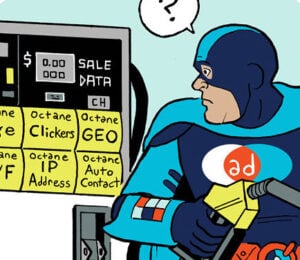No brand is universally known, even ones considered to be “household names.” Fly across the ocean, or even the country, and you’re bound to discover that something you thought was ubiquitous was actually … biquitous?
You get the idea.
Canadian air carrier Porter Airlines takes pride in its “strong brand identity and brand recall within our core Canadian markets,” Director of Marketing Maclin Williams told AdExchanger. Upper-funnel marketing isn’t as important to the airline, since it’s building on nearly 20 years of awareness and cultural familiarity.
At least, that was the case until Porter doubled its fleet size earlier this year and began flying to 25 new markets across North America where relying on last-mile performance marketing wouldn’t suffice.
A new wingman
After the expansion, reaching potential customers in these new regions became a top priority because the new audience overall wasn’t familiar with Porter, said Williams.
The brand therefore decided to focus on “visually captivating” ads, she said, with an emphasis on short-form video content across new channels.
Earlier this year, it partnered with Samsung Ads Canada to blend video ads with the streaming content that Porter’s audience was already consuming, Williams said.
Porter was able to target its new desired audience by features like geographic location and interests, including outdoor content and food.
Instead of providing Samsung with preexisting ad creative to work off of, Porter devised new creative specifically with CTV.
While the CTV ads specifically were new, the practice of “adapting [its] ads to the environment” has always been at the crux of Porter’s strategy, said Williams.
By serving ads that engage directly with viewers – like one that implores its audience to “Get off your couch and onto a plane with no middle seats ever!” – Porter aims to create what Williams calls a “relatable moment” that will stick with the viewer.
Prepare for lift(off)
Samsung’s CTV advertising runs both within streaming content and on the home screen of Samsung smart TVs.
The home screen placements are particularly “high impact,” Dave Pauk, Samsung Ads Country Manager, Canada, told AdExchanger, because they can reach viewers before they’ve even decided what show to watch. Combining home screen ads with in-show ads is the “one-two punch” that sticks with viewers, said Pauk.
And punch it did.
Porter saw a 550% lift in website visits from the campaign compared to unexposed audiences, in addition to vastly improved incremental reach compared to in-show ads alone.
Samsung’s TV operating systems have automatic content recognition (ACR) built into them, a technology that allows it to determine the content users are viewing, both in terms of what shows they’re watching and what ads are showing up.
ACR also enables “granular” targeting based on detailed user data (all privacy compliant, with triple opt-ins, Pauk emphasized), ranging from what show is on the screen down to whether a viewer has a gaming console plugged in, he said.
Rather than lookalike models, all of Samsung’s data is “one-to-one” data that reflects actual users, Pauk added, which gave Porter new insights into target audiences that weren’t as familiar with its brand.
Since Samsung owns 40% of the smart TV market share in Canada according to a spring 2025 report conducted by Media Technology Monitor, a research product that looks at trends in media and tech use across Canada, and CTV supply is composed “primarily of Samsung inventory,” Williams said it made sense to partner with Samsung directly rather than a third party.
After all, with reach like that, the sky’s the limit.












